Controlling the Formation of the Reaction Zone around an Injection Well during Subsurface Iron Removal
Abstract
:1. Introduction
2. Materials and Methods
2.1. Field Site Description
2.2. Well Design
2.3. Technical Layout
2.4. Tracer Tests
2.5. Subsurface Iron Removal Pilot Tests
2.6. Groundwater Sampling
2.7. Water Analysis
3. Results
3.1. Pump and Tracer Tests
3.2. Subsurface Iron Removal Test
3.2.1. Ambient Groundwater Quality
3.2.2. Iron Removal
3.2.3. Hydraulic Effects
4. Discussion
Acknowledgments
Author Contributions
Conflicts of Interest
Abbreviations
| MW: | Ground water monitoring well |
| MP: | Monitoring point |
| SIR: | Subsurface iron removal |
| DO: | Dissolved oxygen |
| EC: | Electrical conductivity |
| c(Fe): | Iron concentration |
| Vin: | Volume injected |
| Vout: | Volume abstracted |
| c/c0: | Normalized concentration |
References
- Appelo, C.A.J.; Drijver, B.; Hekkenberg, R.; de Jonge, M. Modeling in situ iron removal from groundwater. Ground Water 1999, 37, 811–817. [Google Scholar] [CrossRef]
- Meyerhoff, R.; Rott, U. Mass balances for the estimation of the applicability and efficiency for in situ-treatment of iron and manganese containing groundwater. gwf Wasser Abwasser 1997, 138, 173–180. (In German) [Google Scholar]
- Olthoff, R. Groundwater iron removal in aquifers-treatment mechanisms and investigation results. gwf Wasser Abwasser 1988, 129, 327–339. (In German) [Google Scholar]
- Treskatis, C.; Nillert, P. Regular need for adjustment of the DVGW regulatory by progress and practical developments in well design. bbr 2009, 7–8, 44–53. (In German) [Google Scholar]
- Eichhorn, D. Contribution to the Theory of Subsurface Iron Removal. PhD Thesis, Department of Water Sciences, TU Dresden, Dresden, Germany, 1985. [Google Scholar]
- Rott, U.; Kaufmann, H.; Meyer, C. Arsenic elimination in drinking water treatment in developing countries. In Proceedings of the 35 Essener Tagung für Wasser- und Abfallwirtschaft, Essen, Germany, 20–22 March 2002; Wasser Abwasser GWA: Essen, Germany, 2002; Volume 188, pp. 39.1–39.21. (In German)[Google Scholar]
- Winkelnkemper, H. Subsurface iron and manganese removal. wwt Wasserwirtschaft Wassertechnik 2004, 4, 38–41. (In German) [Google Scholar]
- Groth, P.; Bühring, F.; Dannöhl, R.; Ließfeld, R.; Olthoff, R.; Rott, U. Subsurface iron and manganese removal—status report. gwf Wasser Abwasser 1997, 129, 321–327. (In German) [Google Scholar]
- Rott, U.; Friedle, M. Eco-friendly and cost-efficient removal of arsenic, iron and manganese by means of subterranean ground-water treatment. Water Supply 2000, 18, 632–636. [Google Scholar]
- Herlitzius, J.; Bilek, F.; Grischek, T. Subsurface iron and manganese removal. In Proceedings of DGFZ e.V., Grundwassertage; GWZ: Dresden, Germany, 2013; pp. 205–225. (In German) [Google Scholar]
- DVGW. Iron and Manganese Removal—Design and Operational Guidelines for Subsurface Treatment Installations; Worksheet W223-3; German Technical and Scientific Association for Gas and Water: Bonn, Germany, 2005; p. 7. [Google Scholar]
- Houben, G.J. Modeling the buildup of iron oxide encrustations in wells. Ground Water 2006, 42, 78–82. [Google Scholar] [CrossRef]
- Bieske, E.; Rubbert, W.; Treskatis, C. Drilled Wells, 8th ed.; R. Oldenbourg Verlag: München, Wien, Germany, 1998; pp. 191–192. [Google Scholar]
- van Halem, D.; Moed, D.H.; Verberk, J.Q.J.C.; Amy, G.L.; van Dijk, J.C. Cation exchange during subsurface iron removal. Water Res. 2012, 46, 307–315. [Google Scholar] [CrossRef] [PubMed]
- Ebermann, J.P.; Eichhorn, D.; Macheleidt, W.; Ahrns, J.; Grischek, T. Field tests for subsurface iron removal at a dairy farm in Saxony, Germany. In Groundwater Quality Sustainability. Selected Papers on Hydrogeology 17, 1st ed.; Maloszewski, P., Witczak, S., Malina, G., Eds.; Taylor & Francis Group: London, UK, 2012; pp. 29–40. [Google Scholar]
- Grischek, T.; Feistel, U.; Musche, F.; Ebermann, J.; Uhlmann, W. Hydrochemical evaluation of subsurface iron removal in Schleife. In Proceedings of Jahrestagung der Wasserchemischen Gesellschaft, Bamberg, Germany, 2–4 May 2016; Gesellschaft Dt. Chemiker: Bamberg, Germany, 2016; pp. 332–336. (In German)[Google Scholar]
- Roessner, U.; Sailer, C.; Ebermann, J.; Grischek, T.; Plassmann, C. Potential for subsurface iron removal through the use of different injection waters. gwf Wasser Abwasser 2013, 154, 466–472. (In German) [Google Scholar]
- Schöfmann, T. Test on Subsurface Iron and Manganese Removal in Well Group Altmanns Part 2. Diploma Thesis, University of Natural Resources and Life Sciences, Vienna, Austria, 2003. [Google Scholar]
- Rubbert, T.; Treskatis, C. Numerically supported well design for capturing different water qualities. bbr 2008, 12, 80–87. (In German) [Google Scholar]
- Herlitzius, J.; Sumpf, H.; Grischek, T. Design of a large-scale subsurface treatment technology. bbr 2011, 62, 54–57. [Google Scholar]
- Korom, S.F.; Bekker, K.F.; Helweg, O.J. Influence of pump intake location on well efficiency. J. Hydrol. Eng. 2003, 8, 197–203. [Google Scholar] [CrossRef]
- VonHofe, F.; Helweg, O.J. Modeling well hydrodynamics. J. Hydraul. Eng. 1998, 124, 1198–1202. [Google Scholar] [CrossRef]
- Mansuy, N. Water Well Rehabilitation: A Practical Guide to Understanding Well Problems and Solutions; CRC Press: Boca Raton, FL, USA, 1998; pp. 73–74. [Google Scholar]
- Beyer, W. Determination of the hydraulic conductivity of gravels and sands based on grain size analysis. Wasserwirtschaft-Wassertechnik 1964, 14, 165–168. (In German) [Google Scholar]
- Macheleidt, W.; Bartak, R.; Ahrns, J.; Pörschke, J.; Grischek, T. Use of a multilevel sampling system to delineate a subsurface reaction zone. gwf Wasser Abwasser 2016, 157, 847–853. (In German) [Google Scholar]
- Ward, J.D.; Simmons, C.T.; Dillon, P.J.; Pavelic, P. Integrated assessment of lateral flow, density effects and dispersion in aquifer storage and recovery. J. Hydrol. 2009, 370, 83–99. [Google Scholar] [CrossRef]
- Zuurbier, K.G.; Bakker, M.; Zaadnoordijk, J.; Stuyfzand, P.J. Identification of potential sites for aquifer storage and recovery (ASR) in coastal areas using ASR performance estimation methods. Hydrogeol. J. 2013, 21, 1373–1383. [Google Scholar] [CrossRef]
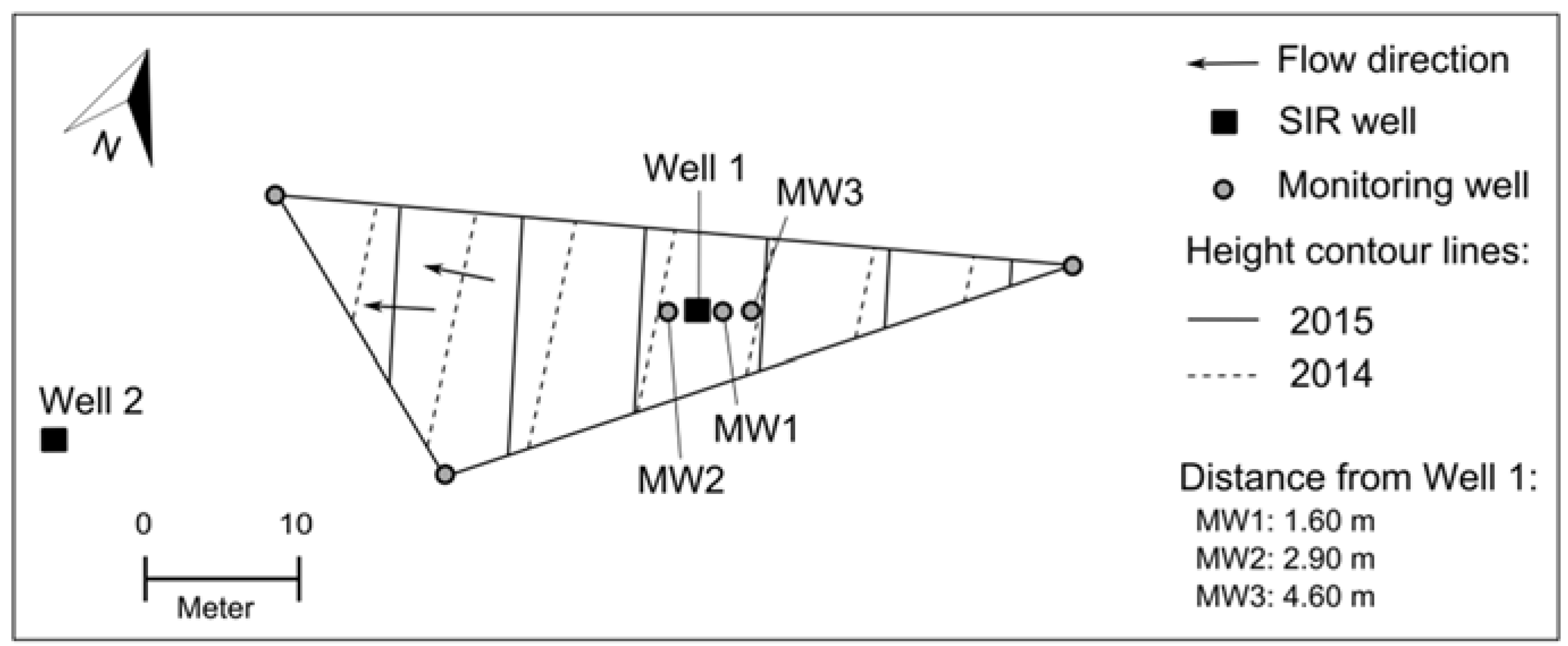
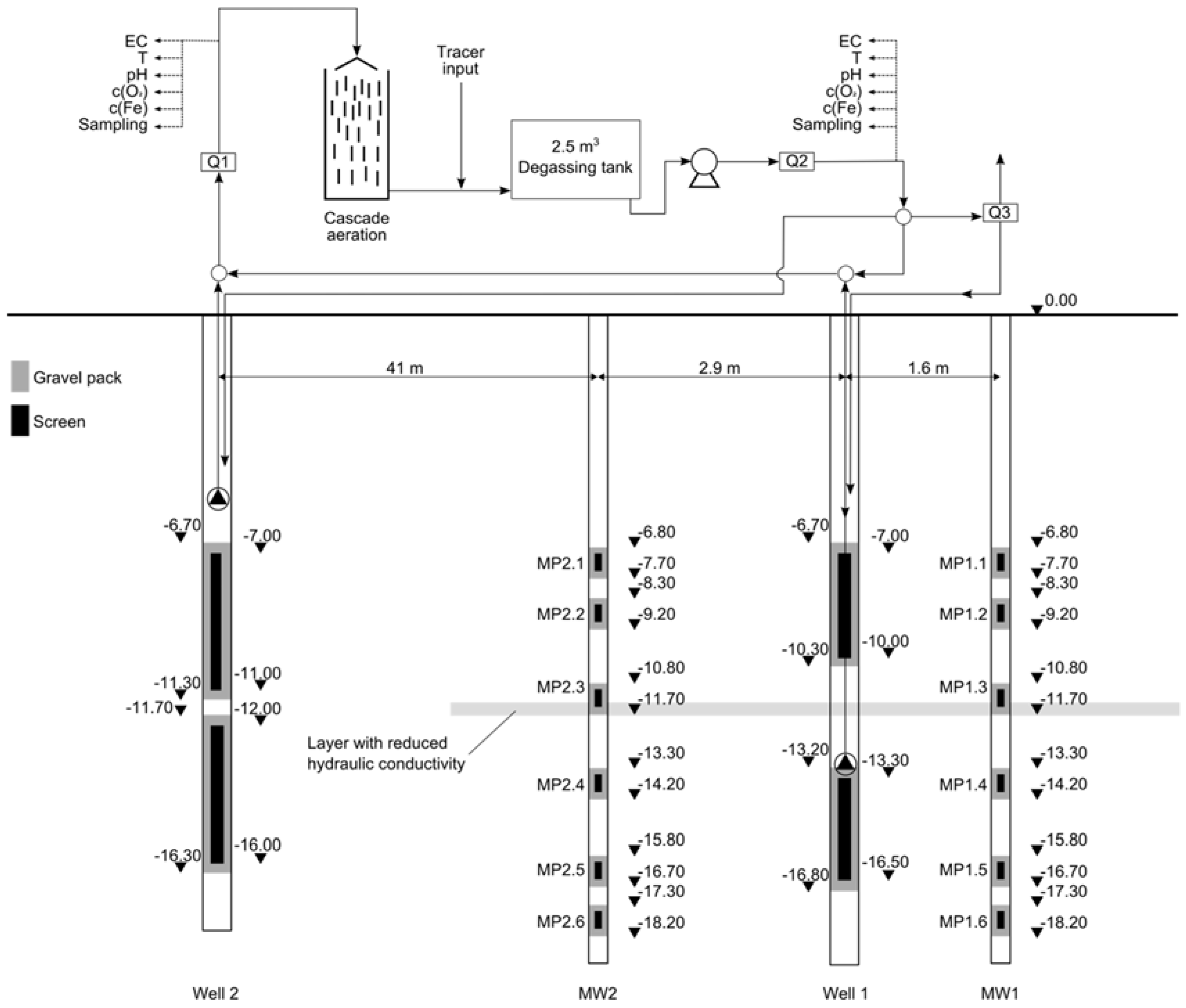
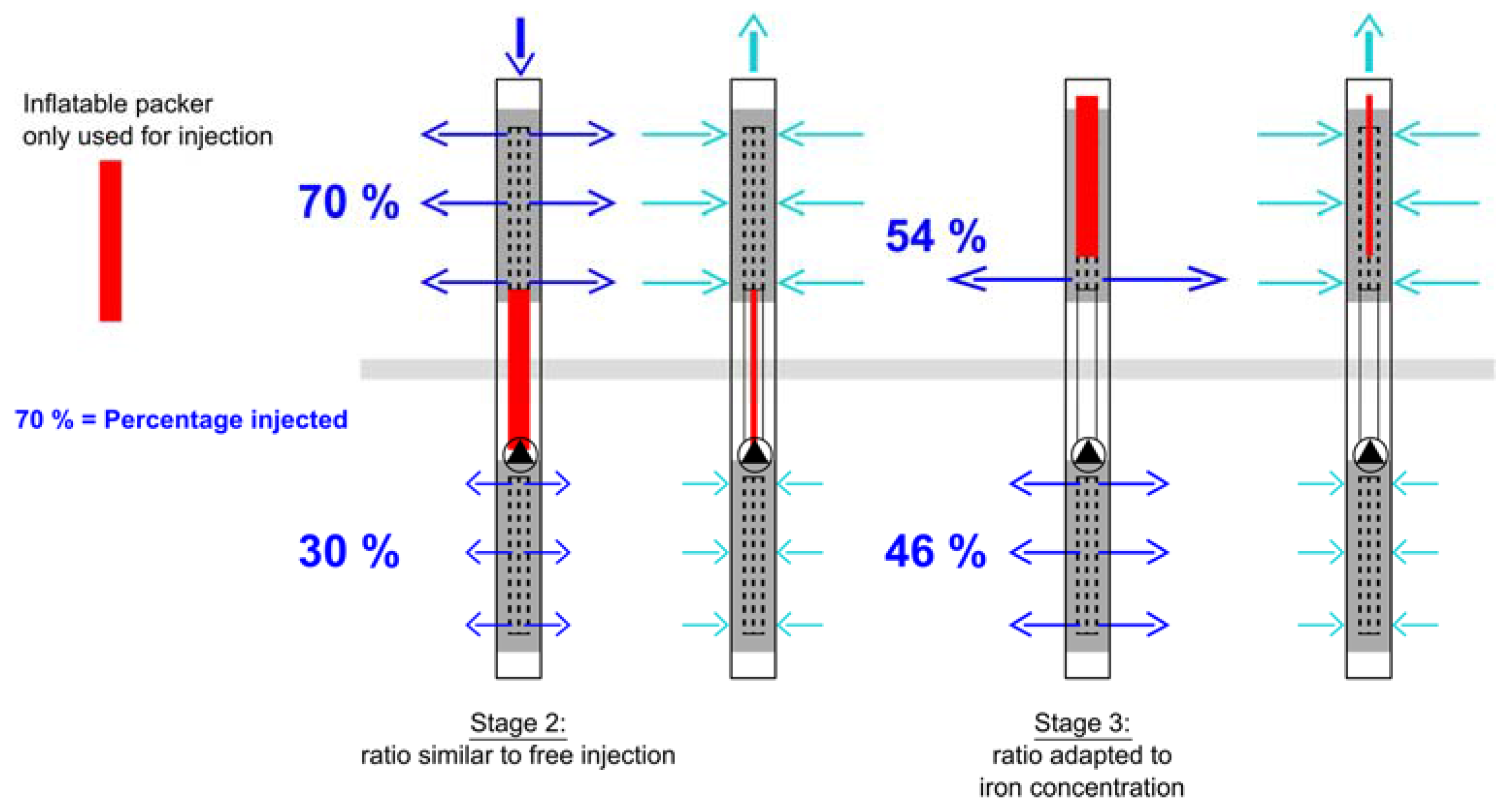
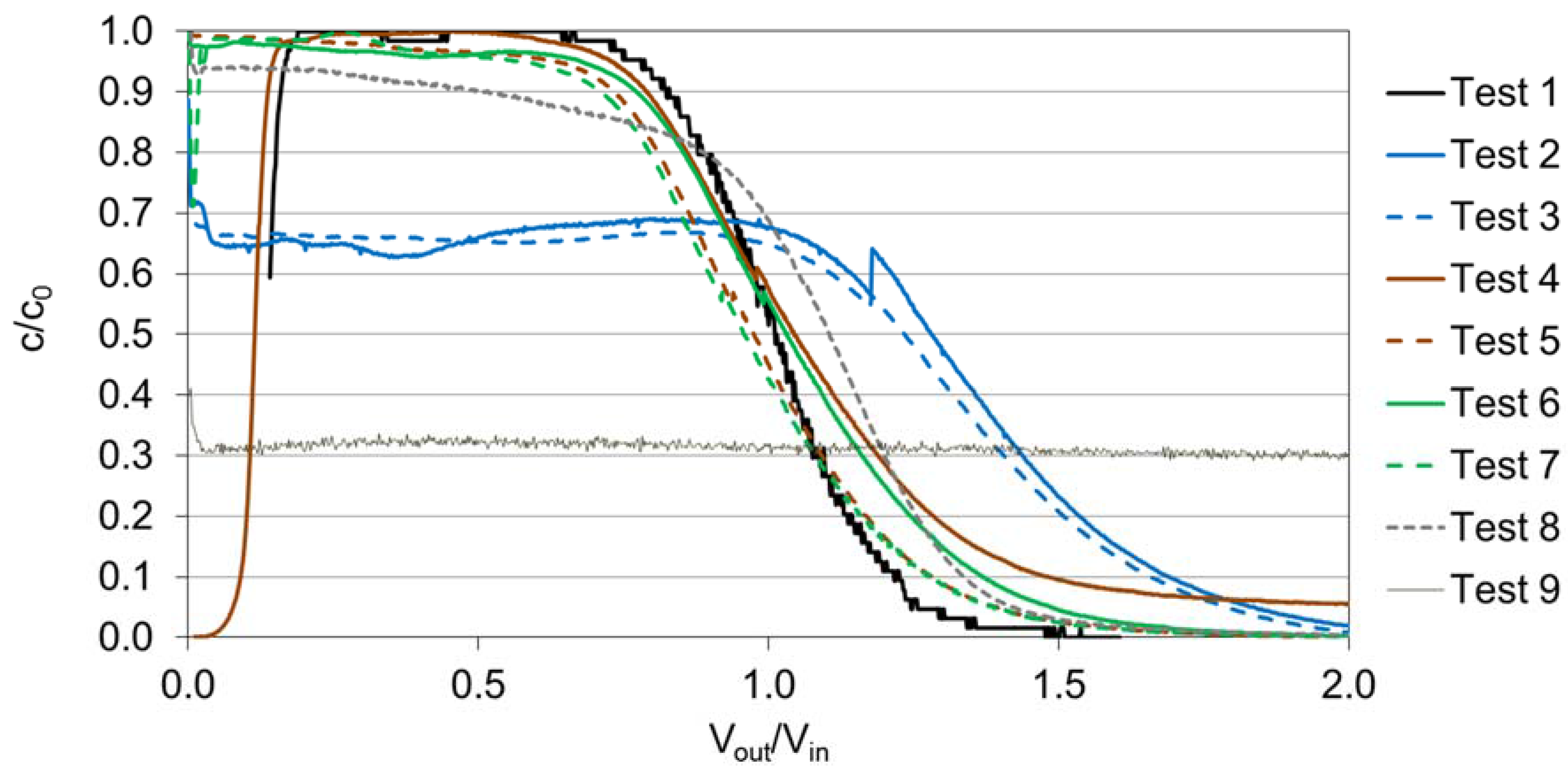


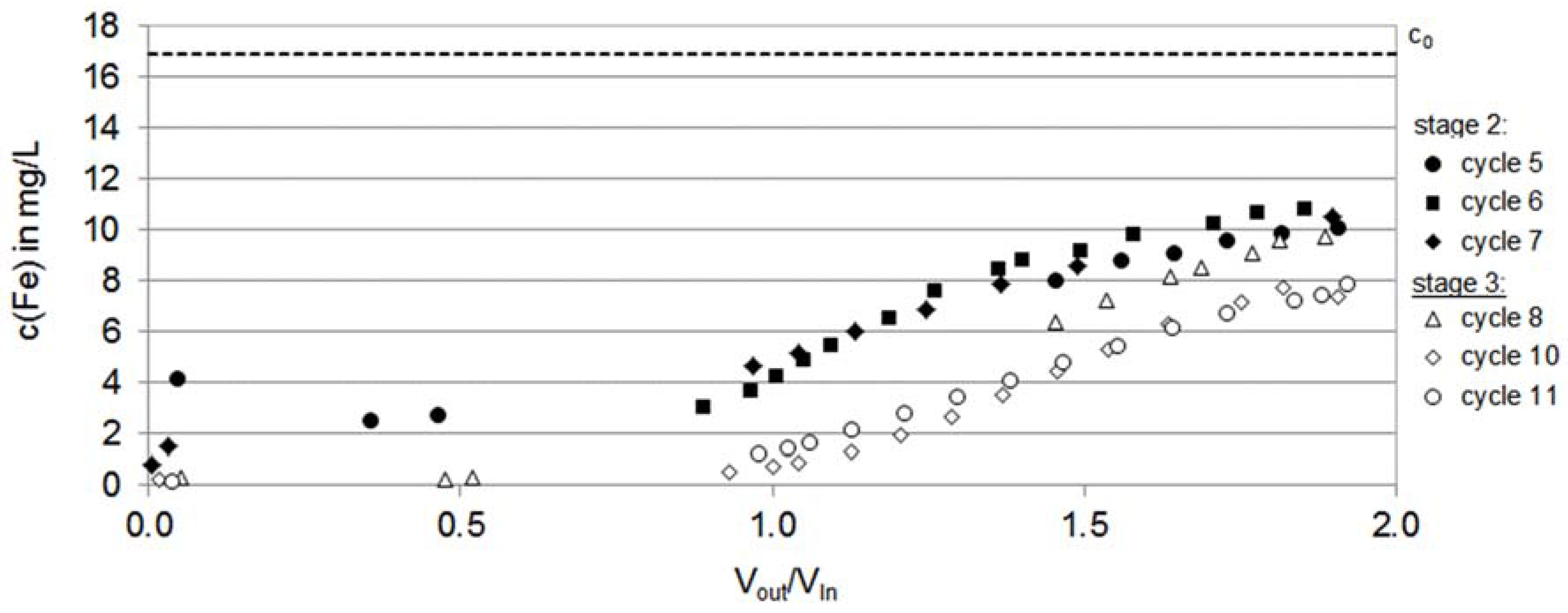

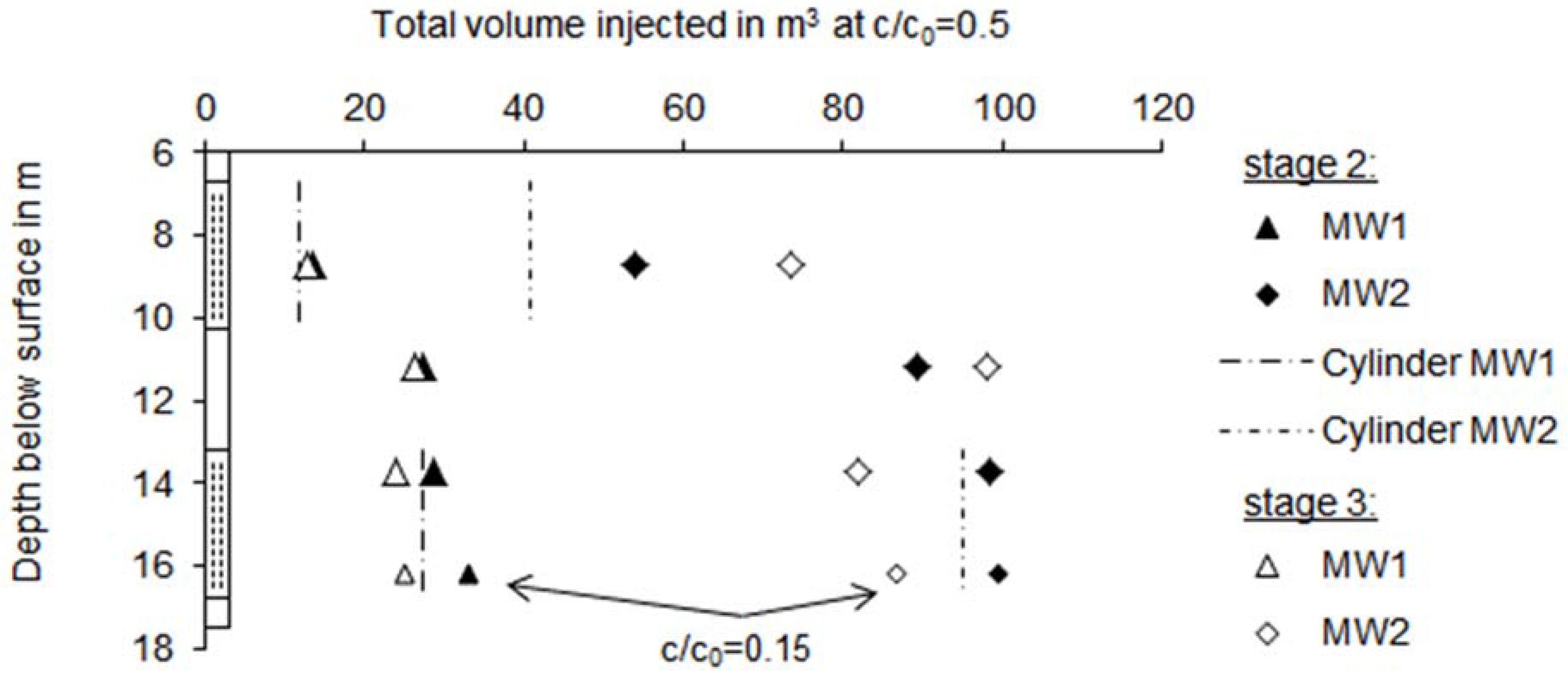
| Test No. | Active Injection Screen | Active Abstraction Screen | Location of Injection Pipe Outlet/Pump Inlet | Injection/Abstraction a Volume in m3 |
|---|---|---|---|---|
| 1 | upper | upper | upper b/upper | 70/115 |
| 2 | upper | both | upper/upper | 58/127 |
| 3 | upper | both | upper/lower c | 60/124 |
| 4 | both | both | upper/upper | 120/255 |
| 5 | both | both | lower/upper | 120/237 |
| 6 | both | both | lower/lower | 120/255 |
| 7 | both | both | upper/lower | 123/303 |
| 8 | lower | lower | lower/lower | 60/134 |
| 9 | lower | both | lower/upper | 60/150 |
| Quarter | 2014 | 2015 | Table | Figure | ||||||||||||
|---|---|---|---|---|---|---|---|---|---|---|---|---|---|---|---|---|
| I | II | III | IV | I | II | III | IV | |||||||||
| Construction | 1, 2 | |||||||||||||||
| Pumping test | ||||||||||||||||
| Water quality | 5a | |||||||||||||||
| Flow meter | ||||||||||||||||
| Tracer test | 1 | 2, 3, 4 | ||||||||||||||
| Modeling | ||||||||||||||||
| Water quality | 2 | 5b | ||||||||||||||
| SIR-pilot test | 2, 5b, 6 | |||||||||||||||
| Tracer test | 7, 8 | |||||||||||||||
| Parameter | Unit | Calc. Both Screens 70:30 | Both Screens | Upper Screen | Lower Screen | Measured Ratio |
|---|---|---|---|---|---|---|
| Q | m³/h | - | 7.7 | 5.5 | 2.4 | - |
| T | °C | - | 10.2 | 10.3 | 10.3 | - |
| pH | - | 6.22 | 6.27 | 6.09 | 6.53 | 59:41 |
| O2 | mg/L | 0.75 | 0.92 | 1.01 | 0.11 | - |
| EC | µS/cm | 281 | 279 | 284 | 275 | 44:56 1 |
| Alkalinity | mmol/L | 0.5 | 0.5 | 0.4 | 0.6 | 59:41 |
| Acidity | mmol/L | 0.8–1.1 | 1.2 | 0.8 | 0.8–1.7 2 | 60:40 |
| Ca2+ | mg/L | 20.8 | 19.5 | 25.4 | 10.2 | 61:39 |
| Mg2+ | mg/L | 6.3 | 6.0 | 7.4 | 3.6 | 62:38 |
| Na+ | mg/L | 6.6 | 6.6 | 6.5 | 6.8 | 67:33 |
| K+ | mg/L | 1.4 | 1.4 | 1.6 | 1.1 | 62:38 |
| Fe | mg/L | 14.4 | 16.9 | 5.6 | 35.0 | 62:38 |
| Mn | mg/L | 0.23 | 0.26 | 0.11 | 0.50 | 62:38 |
| Sr | mg/L | 0.24 | 0.22 | 0.31 | 0.09 | 59:41 |
| Ba | mg/L | 0.05 | 0.05 | 0.06 | 0.04 | - |
| Cl− | mg/L | 21.5 | n.d.3 | 24.9 | 13.5 | - |
| NO3− | mg/L | <0.05 | <0.05 | <0.05 | <0.05 | - |
| SO42− | mg/L | 96 | 94 | 100 | 86 | 57:43 |
© 2017 by the authors. Licensee MDPI, Basel, Switzerland. This article is an open access article distributed under the terms and conditions of the Creative Commons Attribution (CC BY) license ( http://creativecommons.org/licenses/by/4.0/).
Share and Cite
Bartak, R.; Macheleidt, W.; Grischek, T. Controlling the Formation of the Reaction Zone around an Injection Well during Subsurface Iron Removal. Water 2017, 9, 87. https://doi.org/10.3390/w9020087
Bartak R, Macheleidt W, Grischek T. Controlling the Formation of the Reaction Zone around an Injection Well during Subsurface Iron Removal. Water. 2017; 9(2):87. https://doi.org/10.3390/w9020087
Chicago/Turabian StyleBartak, Rico, Wolfgang Macheleidt, and Thomas Grischek. 2017. "Controlling the Formation of the Reaction Zone around an Injection Well during Subsurface Iron Removal" Water 9, no. 2: 87. https://doi.org/10.3390/w9020087





